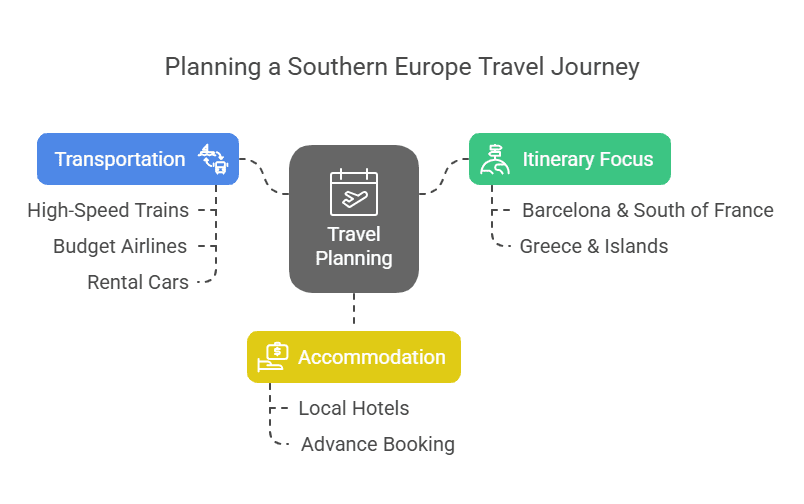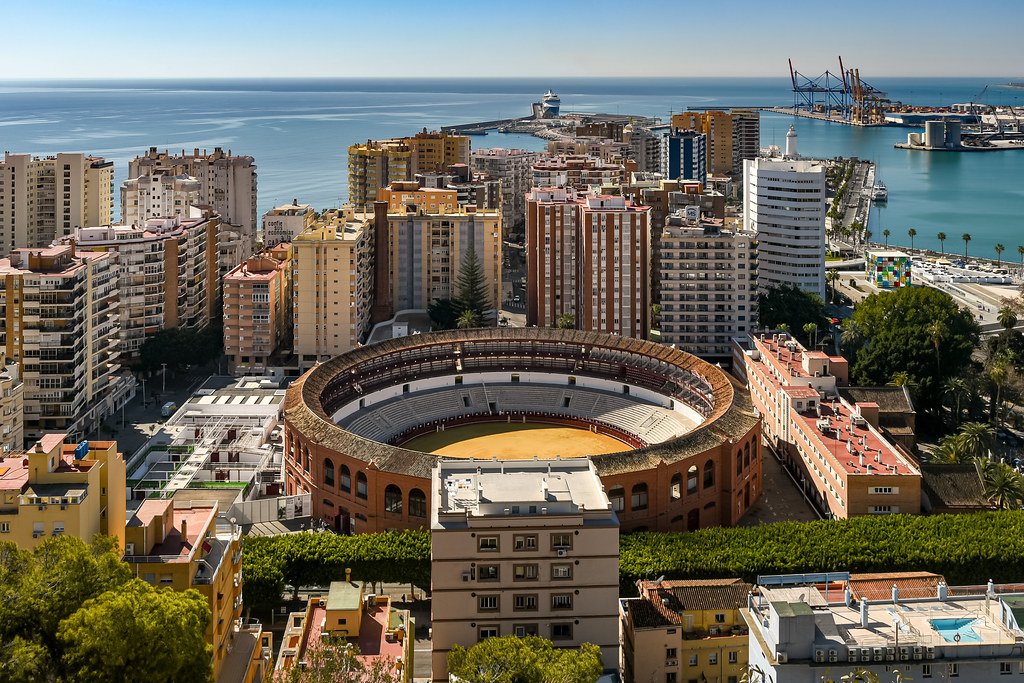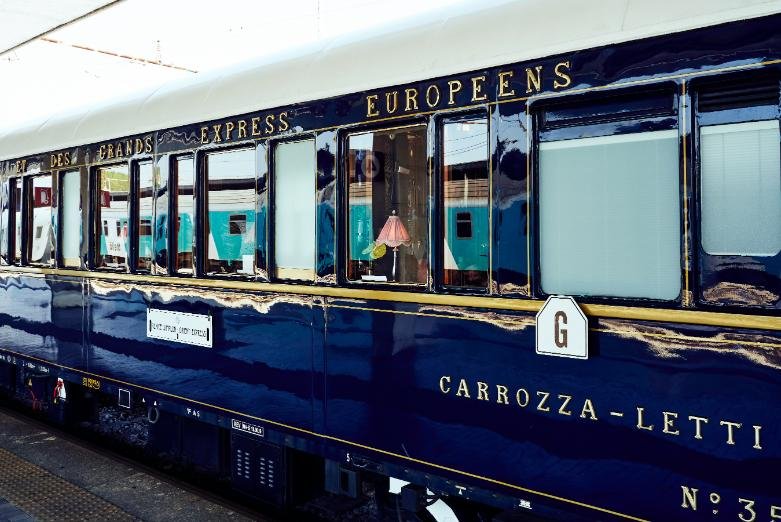Whether you’re dreaming of wandering through narrow streets in historic cities, relaxing on beautiful beaches, indulging in mouthwatering cuisine, or immersing yourself in rich historical narratives, this guide to the southern europe top destinations will help you plan an unforgettable journey through some of the world’s most enchanting locations. It will take you through the most captivating places across Italy, Spain, Portugal, Croatia, Greece, and beyond, helping you craft the perfect itinerary for your Mediterranean adventure.
Key Takeaways: Making the Most of Southern Europe’s Top Destinations
- Prioritize Quality Over Quantity: Rather than rushing between destinations, allocate more time to countries with dense attractions (5-7 days in Italy for Rome, Florence, and the Amalfi Coast) and less to compact nations.
- Consider Seasonal Factors: Visit popular coastal destinations in shoulder seasons (May/June or September/October) to avoid extreme crowds while still enjoying good weather.
- Mix Transportation Options: Use high-speed trains for city-to-city travel, rental cars for rural areas with limited public transit, and budget airlines for longer distances.
- Balance Famous Sites with Hidden Gems: Complement visits to iconic destinations like Barcelona or Santorini with lesser-known spots like the Istrian Peninsula or Malta.
- Embrace Cultural Immersion: Learn basic phrases in local languages, participate in cooking classes or guided tours, and allow time for spontaneous discoveries.
- Book Essential Attractions in Advance: Secure tickets for major sites like the Vatican Museums, Alhambra, or Sagrada Família to avoid disappointment and long lines.
- Plan for Downtime: Include leisurely café visits, beach days, or park strolls to avoid travel burnout and experience local life.
- Consider Multi-Country Logistics: Group nearby destinations by region (Spain + Portugal, or Italy + Croatia) to minimize transit time and maximize exploration.
- Stay Connected: Use multi-country SIM cards or eSIMs for seamless navigation and communication.
- Respect Local Customs: Research and observe cultural norms regarding dress codes at religious sites, meal times, and greeting practices.
Why Southern Europe Should Be Your Next Travel Inspiration
Southern Europe stands as a premier travel destination for countless compelling reasons.
The region’s perfect blend of rich history, diverse cultures, and natural beauty creates an irresistible appeal for travelers seeking authentic experiences.

With its pleasant Mediterranean climate offering plenty of sun throughout much of the year, southern europe top destinations provide ideal conditions for exploration and relaxation alike.
The cultural tapestry of Southern Europe is woven with threads of ancient civilizations, Renaissance art, and modern innovation.
From the birthplace of democracy in Athens to the artistic rebirth in Florence, the region has shaped world history in profound ways.
This cultural richness extends to the region’s cuisine, where fresh local ingredients transform into unforgettable culinary experiences.
Whether you’re savoring paella in Spain, pasta in Italy, or seafood in Portugal, food becomes an integral part of your travel experience.
What truly sets southern European Top destinations apart is their remarkable diversity within relatively short distances.
Within a few hours of travel, you can move from cosmopolitan cities to tranquil islands, from mountain villages to coastal retreats.
This concentration of varied experiences makes Southern Europe particularly appealing for travelers who want to maximize their exploration without exhausting journeys between destinations.
Italy: Renaissance Cities and Mediterranean Coastal Havens
Italy’s contribution to the list of the best destinations in southern europe is nothing short of extraordinary.

Florence, the cradle of Renaissance, stands as an unmissable destination for enthusiasts of history, art, and architecture.
This compact metropolis houses an overwhelming concentration of artistic wonders and cultural treasures—so remarkable that the entire city has been designated a UNESCO World Heritage Site.
Visitors should prioritize seeing Michelangelo’s David sculpture, Botticelli’s paintings, and the awe-inspiring Cathedral of Santa Maria del Fiore with its iconic dome.
Rome, the Eternal City, offers an unparalleled journey through time with ancient ruins like the Colosseum and Roman Forum standing alongside Renaissance and Baroque masterpieces.
The Vatican Museums and St. Peter’s Basilica house some of the world’s most significant artistic and religious treasures.
For travelers seeking coastal beauty, the Amalfi Coast presents a perfect Mediterranean escape with its dramatic cliffs, colorful villages, and crystal-clear waters.
This stunning coastline combines natural landscape with charming towns like Positano and Ravello.
Moving to the islands, Sardinia represents another Italian gem worth exploring. Located in the heart of the Mediterranean, this island might be politically part of Italy, but it possesses a distinct cultural identity that makes it feel like a separate country.
With its crystal-clear waters and pristine beaches, Sardinia offers some of the idyllic coastal experiences in Southern Europe, perfect for travelers seeking relaxation in a breathtaking natural setting.
Sicily, the largest Mediterranean island, adds another dimension to Italy’s offerings with its unique blend of Greek, Roman, Arab, and Norman influences reflected in its architecture, cuisine, and traditions.
Spain’s Unmissable Destinations: From Barcelona to Andalusia
Spain features prominently in any discussion of southern europe top destinations, offering diverse experiences from vibrant cities to sun-drenched coastlines.

Barcelona consistently ranks among the most iconic cities in Southern Europe, serving as a vibrant gateway to the Spanish experience. The city offers an intoxicating blend of architectural marvels, coastal beauty, and pulsating urban energy.
Must-see attractions include Antoni Gaudí’s masterpieces such as Park Güell and the still-under-construction Sagrada Família—both requiring advance booking due to their immense popularity.
The Andalusia region in southern Spain features prominently in recommendations for Southern European Top destinations, particularly the cities of Seville and Granada.
These cities offer a captivating combination of Moorish architectural heritage, vibrant flamenco traditions, and year-round pleasant weather—especially appealing during winter months when northern Europe experiences harsher conditions.
The Alhambra palace in Granada stands as one of Spain’s most visited monuments, showcasing the extraordinary craftsmanship of Islamic architecture.
While Barcelona dominates Catalonia’s tourism landscape, the region offers much more to explore. Cities like Girona and Tarragona provide rich cultural experiences without the crowds of their more famous neighbor.

The Catalonian region as a whole delivers an enticing mix of exceptional food, vibrant nightlife, cultural attractions, picturesque villages, mountain scenery, and Mediterranean coastline.
For travelers seeking warmer climates and unique landscapes, Spain’s Canary Islands—including Tenerife, Gran Canaria, and Fuerteventura—offer a compelling alternative with their distinctly different geography and pleasant year-round temperatures.
Portugal’s Treasures: Lisbon, Porto, and the Algarve
Portugal has firmly established itself among the top destinations southern europe has to offer, with Lisbon leading as one of the region’s premier city-break destinations.

Situated along the banks of the River Tagus and surrounded by seven dramatic hillsides, Portugal’s capital boasts a cityscape of exceptional beauty.
The winding cobbled alleys and colorful mosaic walkways create an enchanting environment for exploration, where getting lost becomes part of the adventure—you might unexpectedly emerge onto a buzzing riverfront or an elegant square.
Porto, with its historical significance and vibrant atmosphere, ranks as another Portuguese must-visit. The city’s historic center is a UNESCO World Heritage Site, and its famous port wine cellars offer delightful tasting experiences.
The Douro Valley, just a short trip from Porto, presents breathtaking landscapes of terraced vineyards along the river, creating one of Portugal’s most picturesque regions.
This area offers wine enthusiasts a chance to explore the birthplace of port wine while enjoying stunning scenery.
For beach lovers, Lagos in the Algarve region offers gorgeous coastlines and excellent cuisine. The Algarve’s combination of golden cliffs, hidden coves, and azure waters makes it one of the best beaches in Southern Europe.
When visiting Lisbon, travelers are frequently advised not to miss the nearby town of Sintra, known for its romantic palaces and lush landscapes.
The colorful Pena Palace stands as a masterpiece of 19th-century Romantic architecture and offers spectacular views across the surrounding forest and coastline.
Croatia’s Adriatic Splendor: Dubrovnik and the Istrian Peninsula
Croatia has emerged as one of the must-visit southern europe spots, with its stunning Adriatic coastline earning worldwide recognition.
Dubrovnik, often called the “Pearl of the Adriatic,” has become a popular destination thanks to its perfectly preserved medieval walls, limestone streets, and dramatic seaside setting.

The city’s historic center is a UNESCO World Heritage Site where visitors can walk atop the ancient walls for breathtaking views of the red-roofed buildings and blue sea beyond.
While the Dalmatian Coast and islands surrounding Dubrovnik often experience heavy tourism during peak season, the Istrian Riviera offers a more tranquil alternative with unspoiled coastline and authentic experiences.
The region boasts some of Europe’s finest beaches, ranging from secluded coves to expansive stretches of sand.
In the port town of Rovinj, visitors can enjoy the unique experience of a seaside forest where one can leap from rocks directly into the azure waters of the Adriatic Sea.
History enthusiasts will appreciate Porec, where pebbly beaches sit adjacent to a town rich with historical treasures, while Pula features a Roman amphitheater that rivals its beaches in popularity. Island hoppers can venture to Krk, Cres, and Rab for additional coastal exploration.
Croatia’s combination of historical landmarks, crystal-clear waters, and Mediterranean atmosphere makes it an essential component of any southern europe travel itinerary, offering experiences that range from cultural immersion to pure relaxation.
You also may like: Ultimate Guide to Traveling to Europe: Everything You Need to Know.
Greece: Athens and Island-Hopping in the Aegean
No exploration of southern europe top destinations would be complete without Greece, a country where ancient history meets Mediterranean beauty. Athens, the birthplace of democracy, offers an unparalleled journey into Western civilization’s foundations.
The Acropolis, crowned by the Parthenon, stands as a testament to Classical Greece’s golden age and provides panoramic views across the sprawling modern city.

Beyond this iconic landmark, Athens offers excellent museums, vibrant neighborhoods, and a thriving food scene that combines traditional and contemporary Greek cuisine.
The Greek islands represent some of the most sought-after destinations across Europe, with Santorini leading as a perennial favorite.
This volcanic island in the Aegean Sea captivates visitors with its whitewashed buildings perched on dramatic cliffs, offering breathtaking views of the caldera.
Santorini’s unique landscape, created by an ancient volcanic eruption, combines with stunning architecture to create one of the most photographed landscapes in the world.
The island’s extraordinary sunset views, particularly from the village of Oia, have become legendary.
Mykonos offers a different Greek island experience, known for its cosmopolitan atmosphere, beautiful beaches, and vibrant nightlife.

For those seeking a more authentic experience with fewer crowds, islands like Crete, the largest Greek island, provide a perfect blend of historical sites, diverse landscapes, and exceptional cuisine.
Greek island-hopping has become a popular way to experience multiple islands in one trip, with efficient ferry services connecting many destinations throughout the Aegean and Ionian seas.
Malta: A Mediterranean Jewel of History and Beauty
Malta may be one of Europe’s smallest countries, but it stands tall among must-visit southern europe spots thanks to its extraordinary historical density and Mediterranean charm.
Valletta, the tiny capital city, packs an impressive amount of history into its 0.3 square miles, with fortress walls, grand palaces, and ornate churches earning it UNESCO World Heritage status.

The city’s grid-like street pattern, established in the 16th century, makes it one of the world’s earliest planned cities.
The island nation’s strategic location in the Mediterranean has made it a crossroads of civilizations for millennia, resulting in a fascinating cultural mosaic.
Prehistoric temples older than Stonehenge, Roman villas, medieval towns, and massive fortifications built by the Knights of St. John all coexist on this compact archipelago.
History buffs will find Malta’s layers of civilization endlessly fascinating, while architecture enthusiasts can admire the distinctive honey-colored limestone buildings that give Maltese towns their warm, golden glow.
Malta’s appeal extends beyond its historical treasures to its beautiful coastline. While sandy beaches are relatively few, the island offers spectacular swimming spots in rocky coves with crystal-clear waters.
The Blue Lagoon on the tiny island of Comino presents one of the Mediterranean’s most picturesque swimming locations, with its turquoise waters creating an almost tropical paradise.
Malta’s compact size makes it ideal for travelers who want to experience diverse attractions within short distances, making it a perfect addition to any southern europe visit.
The French Riviera: Glamour Meets Natural Beauty
The French Riviera (Côte d’Azur) represents the glamorous face of southern europe top destinations, combining sophisticated coastal cities with stunning natural landscape.
Nice, the region’s largest city, offers the perfect introduction to Riviera life with its famous Promenade des Anglais, vibrant old town, and excellent museums dedicated to artists who were inspired by the region’s exceptional light and beauty.

The city’s blend of French and Italian influences creates a unique cultural atmosphere reflected in its architecture and cuisine.
Monaco, though technically an independent principality, forms an integral part of the Riviera experience.
This tiny sovereign state packs extraordinary wealth and glamour into its 2 square kilometers, with attractions including the famous Monte Carlo Casino, the changing of the guard at the Prince’s Palace, and the renowned Oceanographic Museum.
The annual Monaco Grand Prix transforms the city streets into one of the world’s most prestigious Formula 1 racing circuits.
Beyond the famous cities, the French Riviera offers charming villages perched on hillsides and hidden coves along its rugged coastline.

Saint-Paul-de-Vence, Èze, and Mougins provide glimpses into traditional Provençal life, while maintaining sophisticated artistic and culinary scenes.
The region’s combination of natural beauty, cultural richness, and refined lifestyle has attracted visitors for generations, cementing its status among the most desirable southern European destinations.
Cultural Experiences in Southern Europe: Beyond Sightseeing
The southern europe cities offer far more than just beautiful landscapes and historic monuments—they provide immersive cultural experiences that can transform a vacation into a life-enriching journey.
Food and wine play central roles in Southern European cultures, with each region offering distinctive culinary traditions.
Participating in cooking classes, market tours, or wine tastings can provide deeper insights into local life than merely visiting restaurants.
In Italy’s Tuscany, for example, learning to make fresh pasta in a farmhouse kitchen offers both new skills and cultural understanding.
Festivals throughout Southern Europe showcase traditions that often date back centuries.
Spain’s La Tomatina tomato fight, Italy’s historical horse races like Siena’s Palio, Greece’s Easter celebrations, and Portugal’s Santos Populares all offer visitors chances to participate in communal expressions of cultural identity.

These events combine spectacle, tradition, and community participation in ways that reveal the living heritage of these regions.
Language represents another avenue for cultural immersion. While English is widely spoken in tourist areas, learning even basic phrases in Italian, Spanish, Portuguese, or Greek can transform interactions with locals.
Simple greetings or expressions of gratitude open doors to more authentic exchanges and demonstrate respect for the host culture.
This effort is particularly appreciated in smaller towns and rural areas where fewer people speak English and where the connection with traditional ways of life remains strongest.
Planning Your Perfect Southern Europe Travel Journey
Creating an effective southern europe travel track requires balancing ambition with reality to avoid the common pitfall of trying to see too much in too little time.
Rather than attempting to visit every southern europe top destination in a single trip, consider focusing on specific regions or themes.
A two-week trailmight effectively cover Barcelona, the south of France, and northern Italy, or alternatively, Greece and its islands. This approach minimizes transit time and allows for deeper experiences in each location.

Transportation planning forms a crucial part of any Southern European journey. For city-to-city tour, high-speed trains like Spain’s AVE or Italy’s Frecciarossa offer efficient and comfortable connections.
Budget airlines provide economical options for longer distances, while regional trains and buses serve smaller towns and rural areas. For exploring countryside regions like Tuscany or Provence, rental cars provide the flexibility to discover hidden villages and scenic viewpoints.
Island destinations in Greece or Croatia typically require ferry connections, which should be researched in advance, especially during high season.
Accommodation choices significantly impact the journey experience in Southern Europe.
While major cities offer international hotel chains, considering locally owned boutique hotels, guesthouses, or apartments can provide more authentic experiences and often better value.
In popular destinations, particularly during summer months, advance booking is essential.
Many travelers find that mixing accommodation types—perhaps splurging on a sea-view room in Santorini while choosing more modest options in cities where they’ll spend most time exploring—creates a balanced approach to both experience and budget.
Transportation Guide: Navigating Between Southern European Destinations
Navigating between southern europe destinations requires strategic planning to balance time, cost, and comfort considerations.
For budget-conscious travelers, intercity buses represent the most economical option, with companies like FlixBus offering extensive routes connecting major cities across Spain, Italy, and beyond at prices as low as €5-€20.
These services typically provide Wi-Fi and power outlets, making them comfortable for shorter journeys.

Regional operators like Alsa (Spain) and Marino (Italy) fill gaps in coverage for more remote destinations.
For longer distances, budget airlines offer significant time savings at competitive prices when booked well in advance. Carriers such as Ryanair and easyJet connect major hubs throughout Southern Europe for as little as €20-€50 per flight.
While these fares don’t include checked baggage and airports are often located outside city centers, the time saved on routes like Rome to Athens or Lisbon to Barcelona can justify the additional costs and transfer requirements for many travelers.
Trains provide the optimal balance of comfort, convenience, and scenery for many journeys within Southern Europe.
High-speed rail networks in Spain and Italy have dramatically reduced voyage times between major cities, with services like the AVE connecting Madrid to Seville in just 2.5 hours.
While more expensive than buses (for example, Granada to Madrid costs approximately €70 by train versus €17 by bus), trains offer the advantage of city-center arrivals and departures, eliminating additional transfer costs.
For multi-country journeys, options like the Eurail Pass can provide value, particularly when booked in advance.
Hidden Gems: Lesser-Known Southern Europe Destinations
While famous cities and islands dominate most southern europe travel itinerary plans, the region offers numerous lesser-known destinations that reward adventurous travelers.
Naples, Italy provides an authentic, gritty alternative to more polished Italian cities, with extraordinary food, vibrant street life, and convenient access to both Pompeii and the Amalfi Coast.
Similarly, Taormina in Sicily combines historical charm with stunning views of the Mediterranean and Mount Etna, offering a perfect base for exploring eastern Sicily.
On Spain’s southern coast, Malaga has evolved far beyond its reputation as merely a gateway to Costa del Sol resorts. The city now offers beautiful urban spaces, excellent museums (including ones dedicated to native son Picasso), and outstanding cuisine.

Its pleasant year-round climate has attracted a growing community of remote workers, creating a cosmopolitan atmosphere in this historic Mediterranean port.
Inland from Malaga, the “white villages” of Andalusia provide glimpses of traditional Spanish life set among stunning mountain scenery.
Though geographically at the eastern extreme of the Mediterranean, Cyprus—particularly the city of Paphos—offers affordable accommodations during off-peak seasons, widespread English language use, and a significant expatriate community.
The island’s divided status (between Greek and Turkish administrations) creates a unique cultural landscape, while its archaeological sites span multiple civilizations from Ancient Greek to Byzantine.
These less-frequented destinations often provide more authentic experiences and better value than their famous counterparts, making them worthy additions to any exploration of the top southern europe destinations.
FAQ
What are the best southern europe destinations for first-time visitors?
For first-time visitors to Southern Europe, a combination of Italy (Rome, Florence, Venice), Spain (Barcelona, Madrid), and Greece (Athens, Santorini) provides an excellent introduction to the region’s diverse offerings. These destinations offer iconic landmarks, rich cultural experiences, and well-developed tourist infrastructure that makes navigation easier for newcomers.
When is the best time to visit southern europe destinations?
The ideal times to visit Southern Europe are generally late spring (May-June) and early fall (September-October), when you’ll find pleasant temperatures, fewer crowds, and lower prices than during the peak summer season. July and August bring the hottest temperatures and largest crowds, particularly in coastal areas and islands.
How many days should I spend in each southern europe top destination?
For major cities like Rome, Barcelona, or Athens, allocate at least 3-4 days to see the main attractions without rushing. Smaller cities like Florence or Porto can be explored in 2-3 days. For coastal regions or islands that combine relaxation with sightseeing (Amalfi Coast, Greek Islands), consider 4-5 days to fully appreciate their offerings.
What’s the most efficient way to travel between southern europe cities?
For city-to-city tour within the same country, high-speed trains offer the best combination of efficiency and comfort. For longer distances between countries, budget airlines provide the fastest option. Consider move time to and from airports when planning flights, as city-center train stations often offer more convenient departures and arrivals.
Are southern europe countries suitable for budget travelers?
While Southern Europe can be expensive, budget-conscious travelers can still enjoy the region by visiting in shoulder seasons, staying in guesthouses or apartments instead of hotels, eating where locals eat rather than in tourist areas, and using public transportation. Countries like Portugal and parts of Greece tend to be more affordable than popular destinations in Italy or the French Riviera.
Which southern europe destination is best for beach lovers?
For beach enthusiasts, the Greek Islands (especially Crete, Rhodes, and Zakynthos), Croatia’s Dalmatian Coast, Spain’s Costa del Sol and Balearic Islands, and Portugal’s Algarve offer exceptional coastal experiences. Italy’s Sardinia island features some of Europe’s most pristine beaches with remarkably clear waters.
What cultural experiences shouldn’t I miss in southern europe journey?
Don’t miss experiencing a traditional Greek taverna dinner with local music, attending a flamenco performance in Andalusia, participating in an Italian cooking class, exploring local markets everywhere you go, and timing your visit to coincide with local festivals if possible. These cultural touchpoints often create the most memorable moments of a Southern European journey.








